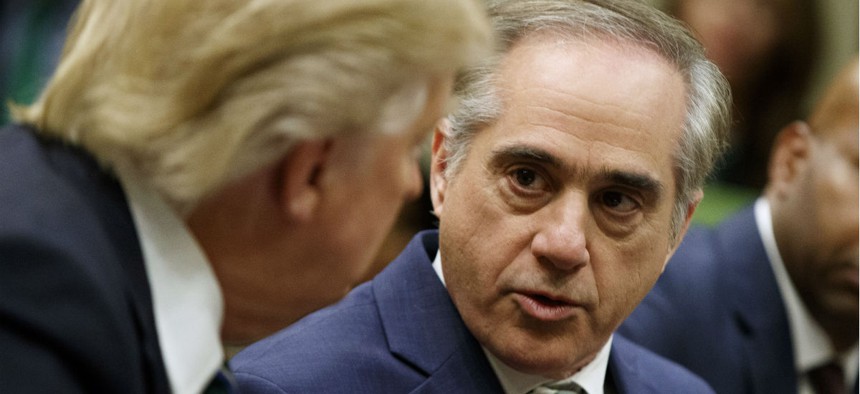
Veteran Affairs Secretary David Shulkin speaks to President Donald Trump during a meeting about veterans affairs March 17. AP Photo/Evan Vucci
Trump Administration Installs Loyalist to Repair Deficient VA Facility
Secretary reiterates call for firing reform, promises to treat employees fairly.
The Veterans Affairs Department has for the second time in two days replaced the director of its medical facility in Washington, D.C., following a devastating report faulting the center for “serious and troubling deficiencies.”
VA on Wednesday immediately relieved the medical center director, Brian Hawkins, of his duties, replacing him with Charles Faselis, who had previously served as the facility’s chief of staff. But Thursday morning, VA changed its mind and decided to replace Faselis with Lawrence Connell, who was serving as a senior advisor to VA on departmentwide programs and strategic issues. In naming Connell to the position, the Trump administration is putting a loyal member of its team in charge of the troubled facility; the retired Army medical service officer was originally sent to VA as part of President Trump’s “landing team” during the transition.
“After further consideration, it was determined that naming an acting director from outside the facility would allow leadership to concentrate on addressing the many challenges identified in the OIG report without compromising the ongoing internal review,” VA said in a statement.
In a press briefing Thursday, VA Secretary David Shulkin said he wanted to place someone “personally coming from my organization” to oversee the facility as it addresses the issues identified in the report.
The IG’s report found scores of examples in which medical supplies at the D.C. medical center were missing, dirty and unaccounted for. The auditors identified examples of facility staff running out of oxygen tubes, alcohol pads, vascular patches and other critical supplies while patients awaited care that required them. The IG faulted management for failing to act on issues they had known about, which ultimately “compromised patient safety.”
The facility also maintained vacancies at key leadership positions, the IG found, as well as longstanding staffing shortfalls in various logistics posts. Additionally, the VA Maryland Health Care System is handling the center’s human resources responsibilities because the D.C. facility has “been unable to sustain and maintain a sufficient HR program.” The IG said this has led to the center not having “direct authority over its recruitment and hiring functions.”
In addition to what VA called an “urgent patient-safety issue,” the disciplinary process that has unfolded highlights an ongoing issue at the department. Shulkin has forcefully advocated for more unilateral authority to swiftly dismiss poorly performing or malfeasant employees. Hawkins is currently working on administrative duties, pending further review. Even if VA decides to fire Hawkins, it will have to provide 30 days notice and the former director can then begin a lengthy appeal process.
Shulkin vowed on Thursday to “act as quickly as possible to hold accountable” anyone responsible for wrongdoing at the facility. He again called for accountability reform to enable him to take “quick, decisive actions,” but said it would have been premature to fire anyone in this case before a investigation was conducted.
He stated his commitment to ensuring VA employees were “treated fairly,” but said “there will be accountability if there is wrongdoing.” He said the action he took Wednesday demonstrates how “an effective organization runs.”
Congress attempted in a 2014 law to expedite the removal process by shortening the advanced notice timeframe and limiting appeal options for senior executives, such as medical center directors, but has opted to no longer pursue that authority after a legal challenge questioned its constitutionality. One notable case also involved a medical center director; VA fired the head of a facility in Albany, N.Y., only to have a judge mandate the department reinstate her.
Concerned Veterans for America, a conservative group and a strong voice advocating for reforming VA’s firing process, said the issues highlighted by the D.C. facility scandal would not subside until Congress takes action on accountability legislation.
“The VA did the right thing by relieving the DC director from his position, but he’s still being paid by taxpayers and under current law it will be very difficult to terminate him,” said CVA Policy Director Dan Caldwell.
J. David Cox, president of the American Federation of Government Employees, which represents about 250,000 VA employees, called the situation “unconscionable,” but said it should not be exploited to expand access to private care or strip career workers of their responsibilities.
“Neither privatization, nor putting political hacks in charge of hospitals is the answer to the crises the IG has identified,” Cox said. “Either of these responses will only worsen the situation at the VA.”
The House last month passed the VA Accountability First Act, which would shrink the notice period for negative personnel action to 10 days. Employees would maintain appeal rights to the Merit Systems Protection Board and U.S. Court of Federal Claims. It would eliminate the ability of union-represented employees to go through the grievance process, which reform advocates have complained takes an average of 350 days.
Sen. Marco Rubio, R-Fla., has introduced companion legislation for the House-backed measure. A spokeswoman for Sen. Johnny Isakson, R-Ga., chairman of the Senate Veterans' Affairs Committee, recently told Government Executive the senator is still “exploring options” for a bill that can pass the Senate. Shulkin has praised the legislation and recently cited an example in which a staffer showed a patient pornography as an example in which it was “unacceptable” the department had to wait 30 days to take action.
With or without movement in Congress, Shulkin promised to act quickly to fix the D.C. facility.
“We have no time to waste,” the secretary said.
NEXT STORY: Why Most Government Reform Plans Die







